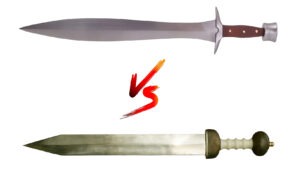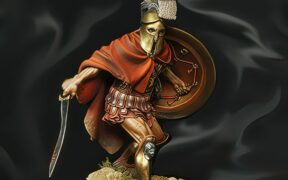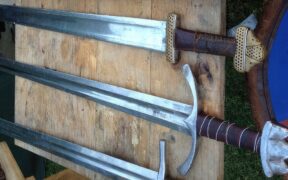Our content features commercial links to our products, committed to transparent, unbiased, and informed editorial recommendations. Learn More
Xiphos Sword: Facts About the Leaf-Bladed Greek Sword
NO AI USED This Article has been written and edited by our team with no help of the AI
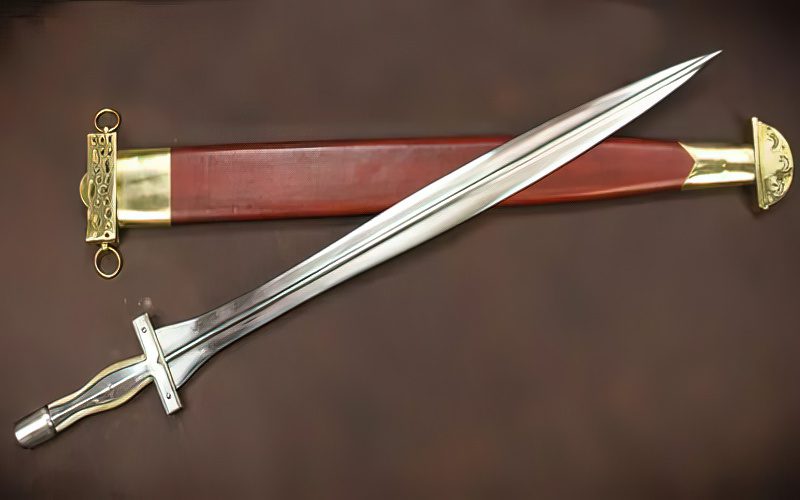
Most recognized for its leaf-shaped blade , the xiphos sword was the secondary weapon of the Greek warriors. In ancient Greece, the hoplites and Spartans used it as a cut-and-thrust weapon in close-quarters combat as soon as their spears had broken off.
Learn more about its history, unique characteristics, uses, and what sets it apart from the kopis or makhaira.
Characteristics of the Greek Xiphos Sword
The xiphos sword has a leaf-shaped blade, making it efficient in cutting and thrusting.
Here are the unique characteristics of the Greek xiphos:
Metal and Construction

As early as 600 BCE, Chalcis, a town on Euboea Island in Greece, was a well-known center of sword production. So, by the post-Homeric times, the xiphos swords were mostly made of iron—or even high-quality Chalcidian steel. The iron and steel technology of the Chalcidians was well-advanced compared to other centers at that time.
Modern replicas of xiphos often have high-carbon steel blades, though spring steel, damascus steel, and stainless steel varieties are not uncommon. There are no surviving manuals on its techniques.
However, many enthusiasts use battle-ready swords with full tang blades for backyard cutting practice. There are also foam-bladed xiphos for live-action role-playing games (LARP).
Blade Appearance
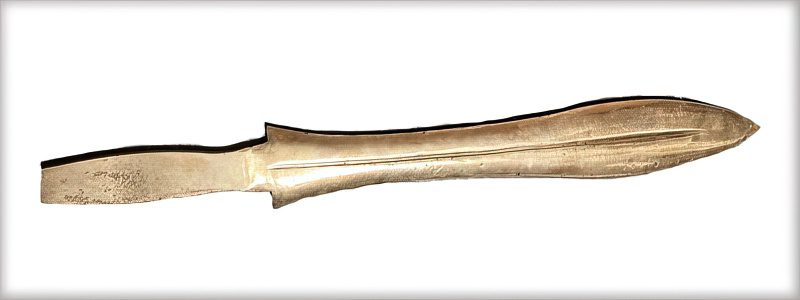
The xiphos has a double-edged, leaf-shaped blade, efficient for both thrusting and slashing. It features a distinctive waist-like neck, broadening near the tip then tapering back to a point. Its leaf-shaped blade made it a weight-forward weapon suited for powerful hacking blows.
At the same time, the xiphos has an acutely pointed tip suited for stabbing. Some historical examples even had straighter and narrower blades maximized for thrusting. It also typically has a diamond cross-section and a central ridge to strengthen its structure.
Size and Length
The xiphos is a short sword usually with a blade length of about 60 centimeters (about 24 inches). However, its overall length varied, as some historical examples were shorter. The Spartans even used swords with a blade length of about 30 centimeters (about 12 inches).
Sword Mounting
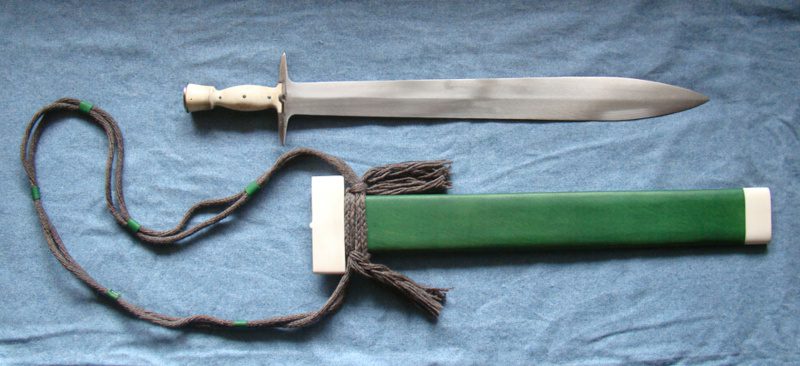
Designed for one-handed use, the xiphos often featured a wooden grip and a bronze pommel. It was also carried in a wooden scabbard and had a crossguard that offered additional protection, preventing the hand from sliding onto the blade. The xiphos’ scabbard had a distinctive T-shaped design to accommodate the flaring of the blade near the crossguard.
The Greek warriors used a shoulder belt or baldric for carrying the xiphos. A baldric was worn over one shoulder across the body. Then, the sword hung from scabbard on the warrior’s left side under the left arm, where he could readily draw it out using his right hand.
Xiphos vs. Kopis
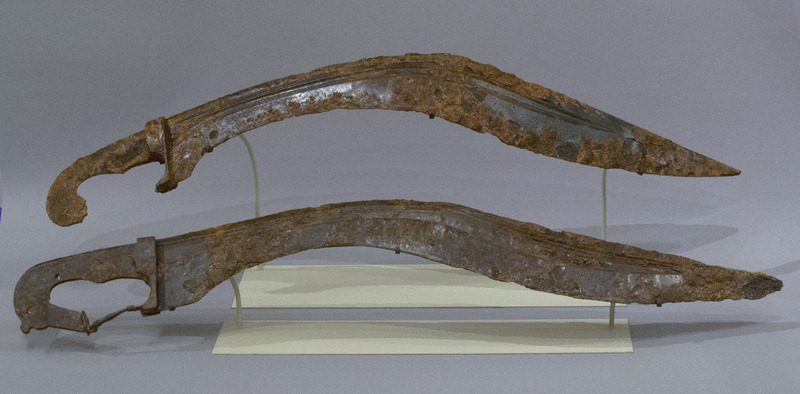
The Greek hoplites also used the kopis, also called makhaira, as a chopping weapon. In fact, the term kopis comes from the term kopto, meaning cut. While the xiphos had a leaf-shaped blade, the kopis had a recurved blade, efficient in delivering heavy cutting blows. Although the kopis was well-suited to close-quarters combat, the cavalry also used it when fighting from horseback.
| Type of Sword | Xiphos | Kopis |
| Blade Appearance | Leaf-shaped blade, broadening out before the point. | Recurved blade or hooked forward blade, widening towards the point. |
| Cutting Edge | Double-edged blade | Single-edged blade |
| Cross-section | A flattened diamond cross-section | A wedge-shaped cross-section |
| Blade Length | Average of 60 centimeters, though some were as short as 30 centimeters. | Not standardized; Average of 50 to 60 centimeters. |
| Hilt | Cross hilt | L-shaped or bird-shaped grip |
| Sword Guard | Crossguard | Without a crossguard, though some had a knuckle guard. |
| Uses | Ideal for cutting, slashing, and thrusting. | Ideal for chopping, slashing, and drawing cuts, but can also be used for thrusting. |
| Techniques | Used as a cut-and-thrust sword | Used like an ax in a downward hacking motion. |
Greek Xiphos vs. Roman Gladius

The Roman legionaries used a short sword called gladius. It varied greatly in appearance throughout the Roman era, though its earlier types had a classic waisted form similar to the xiphos. It served as the primary sword of foot soldiers until the long sword spatha replaced it.
Both the xiphos and gladius sword were efficient in thrusting and cutting, though the Romans primarily used their sword for stabbing. Even though the Greeks fought with steel swords, their xiphos were inferior in construction and design to the Roman sword.
Greek Xiphos vs. Celtic Long Sword
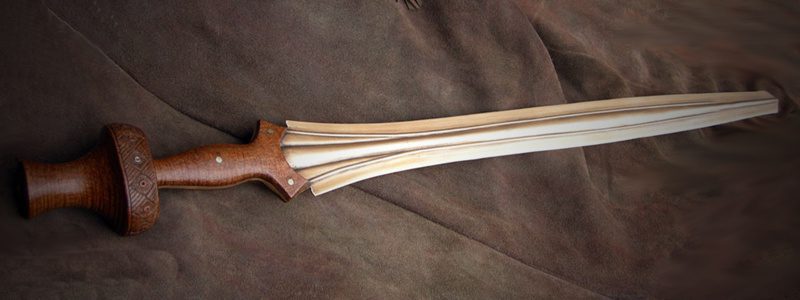
There were various types of Celtic long swords, but the Mindelheim type had a leaf-shaped blade similar to the xiphos. The Celts widely used them in raids and warfare.
| Type of Sword | Greek Xiphos | Celtic Sword (Mindelheim type) |
| Blade Appearance | Double-edged leaf-shaped blade with a narrow waist | Double-edged leaf-shaped blade with a narrow waist |
| Point | Featured an acutely pointed tip | Early blades had sharp tapering tips, but later ones were rounded. |
| Size | A short sword, with an average blade length of 60 centimeters or shorter. | A long sword that varied in length. La Tène period blades were around 80 to 90 centimeters long. |
| Pommel | Cap pommel (usually bronze) | Hat-shaped pommel (wood, bronze, ivory) or disk-shaped buttons. |
| Use | The Greeks utilized it for cutting, slashing, and thrusting. | The Celts preferred slashing over thrusting. |
History of the Greek Xiphos Sword
The term xiphos is a generic term for sword, though it has come to be associated with the Greek leaf-shaped sword. The xiphos was the typical sword of Classical Greece and Hellenistic Greece and even existed before the hoplite era.
- The xiphos served as a secondary weapon to the spear.
The Greek hoplites relied on their thrusting spear called dory. They also used a javelin, a shorter spear designed to be thrown. When it was dropped or broken, the xiphos would serve as a weapon of last defense suited to close-quarters combat. Also, the spear became inefficient when the enemy got too close, as a soldier needed to reach back far enough to use it.
- The Athenian and Spartan hoplites were similar in their weapons and tactics.
Sparta was a militarized state, but Athens had citizen soldiers fighting for their city where most had little to no military training. Both hoplites used spears, javelin, shields, and iron swords to fight in a tight phalanx formation.
- The Spartans preferred shorter swords and fought closer to the enemy.
The Spartans also favored the leaf-shaped blade of the xiphos, but their swords were generally shorter than the typical swords used by other Greeks. Sometimes considered a dagger, the Spartan sword was called encheiridion, meaning little hand weapon. Despite its shortness, it remained efficient as Spartans fought in close range to their enemy.
- The Macedonian hoplites used a long spear called sarissa.
When Philip II of Macedonia conquered the Greek city-states, the hoplites became a secondary force in his army. He equipped them with sarissa, which was significantly longer than the dory and more difficult to handle. The purpose of the sarissa was to hold off the enemy, so the xiphos served as a weapon of last resort.
- At the Battle of Pydna, the Macedonians used their xiphos in hand-to-hand combat.
The battle of Pydna was a decisive Roman victory over Macedonia and established Rome as the dominant power in the Mediterranean. The Macedonians were equipped with sarissas and xiphos swords but were forced to use the latter when their tight phalanx formation broke. However, the Roman legionaries were more flexible and used their short swords more efficiently in close-quarters combat.
Conclusion
The ancient Greeks used various swords, but the xiphos was more efficient in cutting and thrusting. It was also a significant part of Greek warfare, being the secondary weapon to the spear. Nowadays, the Greek sword remains popular in pop culture, historical reenactment, and LARP.
